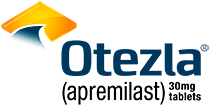First and only oral therapy approved for mild, moderate, and severe plaque psoriasis, and active PsA SEE THE DATA

Plaque Psoriasis
4 INDICATIONS Otezla® (apremilast) is indicated for the treatment of adult patients with plaque psoriasis who are candidates for phototherapy or systemic therapy. Read more
*Estimates of patients treated reflect global data since launch (Apr 2014-Mar 2023; US=59% of data). Calculations based on observed drug utilization parameters and number of units distributed. Utilization patterns change over time to best represent current markets.
FDA, U.S. Food and Drug Administration; PsA, psoriatic arthritis; TB, tuberculosis.
References: 1. Otezla [package insert]. Thousand Oaks, CA: Amgen Inc. 2. Data on file, Amgen Inc. 3. Otezla® (apremilast) FDA approval letter. March 21, 2014.

Analyses at week 2 are exploratory and have not been adjusted for multiple comparisons. No statistical or clinical conclusions can be drawn.
*In patients with WBI-NRS ≥4 at baseline.


§FAS. **Baseline mean pruritus VAS scores (mm): Otezla, 66.2; placebo, 65.2. ††Week 16: secondary endpoint; all other timepoints: exploratory endpoints.
‡‡Randomized treatment withdrawal phase (weeks 32 to 52) where additional psoriasis therapies, including topicals and/or phototherapy, could have been added to PASI-75 nonresponders. Please see study design for additional information.

§§Patients rated their scalp itch on a scale of 0 (no itch) to 10 (worst imaginable itch). Analyses were based on patients in the ITT population with baseline scalp itch NRS score ≥4. ***Scalp itch NRS response was defined as a ≥4-point reduction (improvement) from baseline. At baseline, the mean scalp itch NRS score was 6.7, with scales ranging from 0 to 10. †††Due to the MI method used to analyze the data, the n value for patients who achieved response may be in decimals.
Error bars represent 95% confidence interval. 3

of patients taking Otezla achieved a ≥4-point improvement from baseline in scalp itch NRS scores at week 16 vs placebo (21%) (P<0.0001) 5
Significant improvement
in scalp itch as early as


‡‡‡Patients rated their whole body itch on a scale of 0 (no itch) to 10 (worst imaginable itch). Analyses were based on patients in the ITT population with baseline whole body NRS score ≥4. At baseline, the mean whole body itch NRS score was 7.2, with the scores ranging from 0 to 10. §§§Whole body itch NRS response was defined as a ≥4-point reduction (improvement) from baseline. ****Due to the MI method used to analyze the data, the n value for subjects who achieved response may be in decimals.
Error bars represent 95% confidence interval. 3

of patients taking Otezla achieved a
≥4-point improvement from baseline
in WBI-NRS scores at week 16
vs placebo (23%) (P<0.0001) 5
Significant improvement
in scalp itch as early as

This is an exploratory analysis and has not been adjusted for multiple comparisons. No conclusions of statistical or clinical significance can be drawn. 3,6
††††GPI-NRS response is defined as at least a 4-point reduction (improvement) at week 16 in patients with baseline GPI-NRS score ≥4; GPI-NRS scores range from 0 (no) to 10 (worst imaginable).
BID, twice daily; BL, baseline; BSA, body surface area; FAS, full analysis set; ITT, intent to treat; MI, multiple imputation; NRS, numeric rating scale; PASI, Psoriasis Area and Severity Index; PASI-75, a 75% reduction in a patient's PASI score; ScPGA, Scalp Physician Global Assessment; SE, standard error; sPGA, static Physician Global Assessment; sPGA-G, static Physician Global Assessment of Genitalia; SSA, scalp surface area; VAS, visual analog scale; WBI-NRS, whole body itch numeric rating scale.
Contraindications
Otezla® (apremilast) is contraindicated in patients with a known hypersensitivity to apremilast or to any of the excipients in the formulationWarnings and Precautions
Hypersensitivity reactions, including angioedema and anaphylaxis, have been reported during postmarketing surveillance. If signs or symptoms of serious hypersensitivity reactions occur, discontinue Otezla and institute appropriate therapyContraindications
Warnings and Precautions
Adverse Reactions
Use in Specific Populations
Otezla is indicated for the treatment of:
Please click here for the full Prescribing Information.
References: 1. Otezla [package insert]. Thousand Oaks, CA: Amgen Inc. 2. Stein Gold L, Papp K, Pariser D, et al. J Am Acad Dermatol. 2022;86(1):77-85. 3. Data on file, Amgen; 2022. 4. Papp K, Reich K, Leonardi CL, et al. J Am Acad Dermatol. 2015;73(1):37-49. 5. Van Voorhees AS, Gold LS, Lebwohl M, et al. J Am Acad Dermatol. 2020;83(1):96-103. 6. Reich K, Gooderham M, Green L, et al. J Eur Acad Dermatol Venereol. 2017;31(3):507-517.